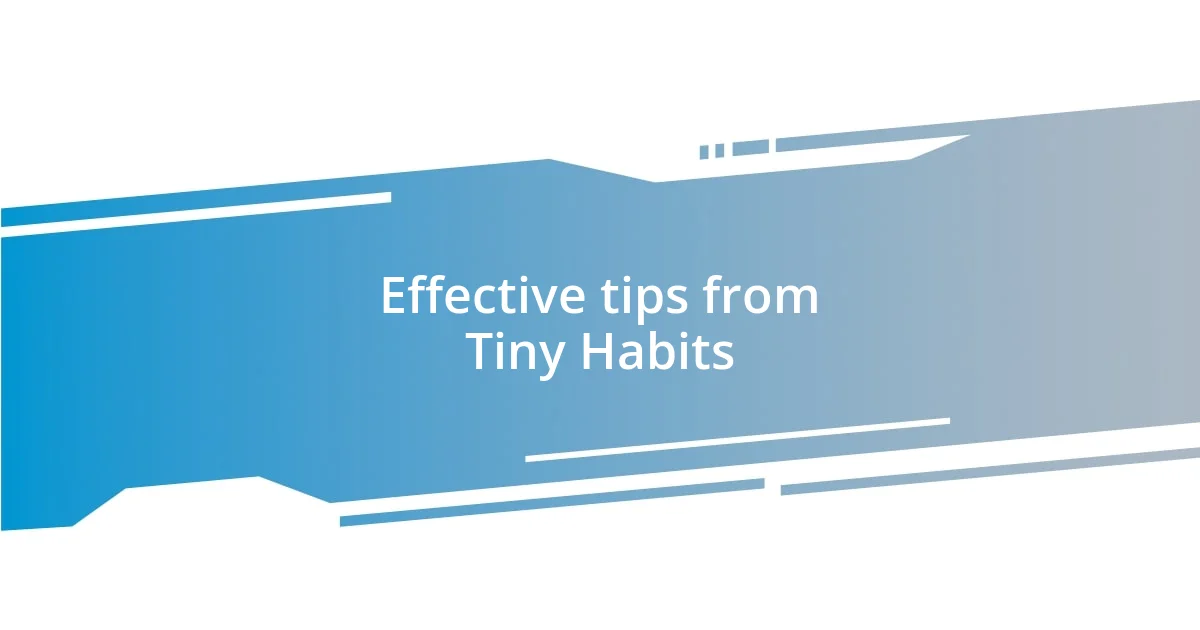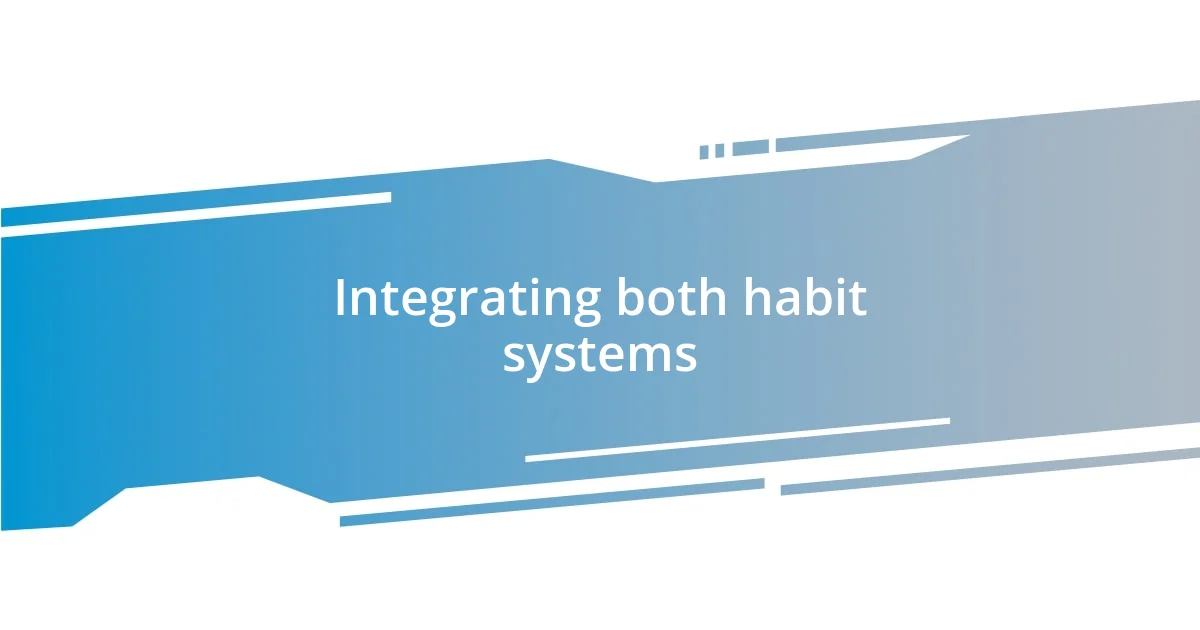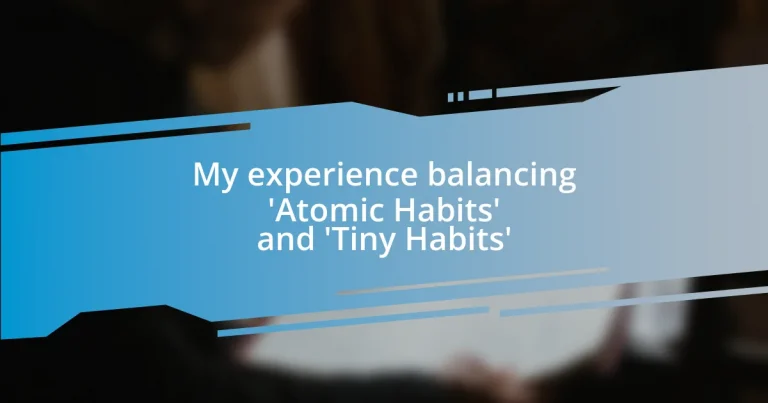Key takeaways:
- Small changes can lead to significant improvements; consistency and identity change are crucial in habit formation.
- Utilizing strategies like habit stacking, tracking progress, and celebrating small wins can enhance motivation and success in building new habits.
- Integrating the principles of both Atomic Habits and Tiny Habits allows for flexibility, resilience, and a more enjoyable journey toward personal growth.

Understanding the core principles
Understanding the core principles of both Atomic Habits and Tiny Habits starts with the idea that small changes can lead to significant improvements over time. I remember when I first grasped this concept; it felt like a light bulb switched on. I had been searching for a magic solution to my productivity issues, but the reality is much simpler: consistency is key.
The principle of identity change, which is central to Atomic Habits, emphasizes that our habits shape who we are. I often reflect on this idea when I realize that every time I choose to write even just a paragraph, I’m reinforcing my identity as a writer. Isn’t it fascinating how our daily choices build our self-image? This perspective shifted how I approached my own habits, making me more intentional about every small action I take.
Meanwhile, Tiny Habits focuses on ease and accessibility, suggesting we start with something so simple it feels ridiculous. For example, I began flossing just one tooth, a habit so small I couldn’t resist doing it. Over time, this tiny step cascaded into a more robust dental care routine. Isn’t it amazing how even the slightest change can snowball into significant, lasting habits? Understanding these principles helped me appreciate the power of incremental progress and the pivotal role emotions play in habit formation.

Key strategies from Atomic Habits
The strategies in Atomic Habits revolve around the concept of the four laws: cue, craving, response, and reward. I found this framework immensely helpful when trying to create new routines. For instance, when I wanted to read more books, I set a specific cue: placing a book on my pillow each morning. This simple action triggered the craving to read before bed, ultimately transforming reading into a delightful evening ritual.
Another important strategy is the idea of habit stacking, which I’ve incorporated into my daily life. This technique involves attaching a new habit to an existing one. For example, after I finish my morning coffee, I use that moment to meditate for just two minutes. It’s incredible how linking these habits makes it easier to remember, and before I knew it, those two minutes of meditation evolved into a longer, more fulfilling practice.
Lastly, the importance of tracking progress can’t be underestimated. I started using a habit tracker app, and it became surprisingly motivating. Seeing a visual representation of my consistency keeps me committed to my goals, allowing me to celebrate those small wins that keep the momentum flowing. Isn’t it rewarding to see how far you’ve come, even with tiny steps?
| Key Strategies | Example from My Experience |
|---|---|
| Four Laws of Behavior Change | Using cues to encourage new habits, like placing a book on my pillow to read more. |
| Habit Stacking | Linking meditation to my morning coffee routine, making it easier to remember. |
| Tracking Progress | Using a habit tracker app to visualize consistency and celebrate small wins. |

Effective tips from Tiny Habits
The Tiny Habits method emphasizes starting with incredibly small actions, which can eventually snowball into broader changes. I vividly recall my first attempt at implementing Tiny Habits; I chose to simply take one minute to breathe deeply each morning. That initial minute felt so easy that I couldn’t justify skipping it. Gradually, I found myself extending those sessions as I began to crave that calmness, illustrating how powerful it is to keep things simple.
Effective tips from Tiny Habits often revolve around celebrating small wins. It might sound trivial, but when I acknowledged my little successes—like drinking a glass of water after brushing my teeth—it transformed my outlook. These celebrations foster positive emotions, reinforcing the desire to continue those behaviors. Here are some practical tips I found beneficial:
- **Start ridiculously small:** Choose a habit that feels so easy, it barely takes any effort—like putting on your workout shoes.
- **Celebrate immediately:** After completing your tiny habit, do a little cheer for yourself or high-five someone. Positive reinforcement can amplify your motivation.
- **Focus on emotions:** Reflect on how accomplishing your tiny habit makes you feel, connecting with the joy of progress.

Integrating both habit systems
Integrating both the Atomic and Tiny Habits systems has truly transformed my approach to personal growth. I’ve found that combining the robust frameworks of Atomic Habits with the simplicity of Tiny Habits creates a unique synergy. For instance, when I was trying to increase my water intake, I started with the Atomic strategy of habit stacking by placing my water bottle next to my morning coffee. Then, I adopted the Tiny Habits approach by committing to drink just one sip right after my first sip of coffee. The result? It felt manageable and soon became a habit I didn’t want to skip!
One of the most enlightening experiences came when I began to celebrate the small wins from both methods. Imagine this: after I successfully completed my tiny sip of water, I would give myself a mental high-five and remind myself how great it felt to be hydrated. This simple act of recognition not only reinforced my new habit but also strengthened my motivation to keep going. Have you ever noticed how a little acknowledgment can spark a seemingly bigger change in your life?
As I blended these two habit systems, I also realized the importance of flexibility. Initially, I’d rigidly followed the four laws of Atomic Habits, but I discovered the beauty of adjusting my approach based on what felt right in the moment. For example, on days when I just wasn’t in the mood for my usual meditation routine, I would opt for a tiny habit instead—like taking three deep breaths. This adaptability made my journey feel less daunting and a lot more enjoyable, turning habit formation into a satisfying and rewarding experience instead of a chore. How do you nurture flexibility in your own habit-building efforts?

Overcoming common challenges
Balancing the challenges of establishing new habits can sometimes feel overwhelming, especially when we set high expectations for ourselves. I remember days when I’d intended to incorporate several big changes simultaneously, only to find myself frustrated and disheartened. What I learned is that breaking down those ambitious goals into smaller, more manageable steps is crucial. For instance, rather than aiming to meditate for 20 minutes daily right away, I started with a mere two minutes, which felt much more achievable.
One of the most significant hurdles was combating the urge to abandon my efforts after minor setbacks. On a particularly busy week, I missed my intended habits entirely, and it was easy to spiral into negative thinking. However, I found that reframing those moments as learning opportunities really helped. Instead of viewing them as failures, I chose to ask myself, “What can I adjust next time?” This shift in mindset not only fostered resilience but also made me more committed to continuing my journey.
Sometimes, it can get lonely on this path of personal growth, and I often missed the sense of community that comes from shared experiences. I started reaching out to friends who were on similar journeys. We even celebrated each other’s small wins together. Have you ever felt that collective support can amplify your motivation? That connection made it easier to push through challenging days and reignited my enthusiasm for habit-building. It’s amazing how connecting with others can transform a solitary journey into a collaborative adventure!

Measuring your progress and success
Measuring progress and success can be both a rewarding and a challenging part of habit formation. I remember when I first started tracking my habits; I used a simple checklist on a notepad. Each tick felt like an achievement, and even the smallest completion ignited a sense of accomplishment in me. Have you ever experienced that burst of joy from checking off a task? It’s a little thing, but it can have a big impact on your motivation.
As I grew more accustomed to my progress tracking, I began noticing patterns in my habits. For instance, I realized that my energy levels fluctuated, which directly influenced my commitment to certain activities. I would ask myself, “Why did I miss my workout two days in a row?” Analyzing those moments helped me adjust my expectations and set more realistic goals. Have you found that reflecting on your behaviors can lead to better insight into your routines?
Ultimately, I discovered that celebrating both small and big milestones is essential. I started treating myself to a favorite treat or a quiet evening of relaxation whenever I hit a significant goal. This practice not only reinforced my commitment but also made the entire process more enjoyable. It’s interesting how taking a moment to celebrate progress turns habit-forming into a more positive experience, isn’t it?














